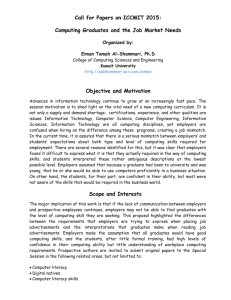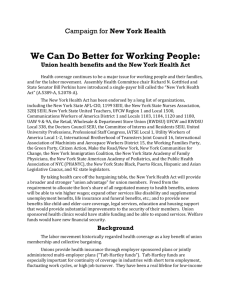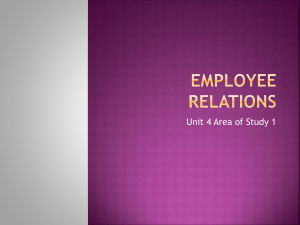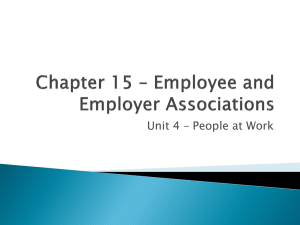DOCX 134KB
advertisement
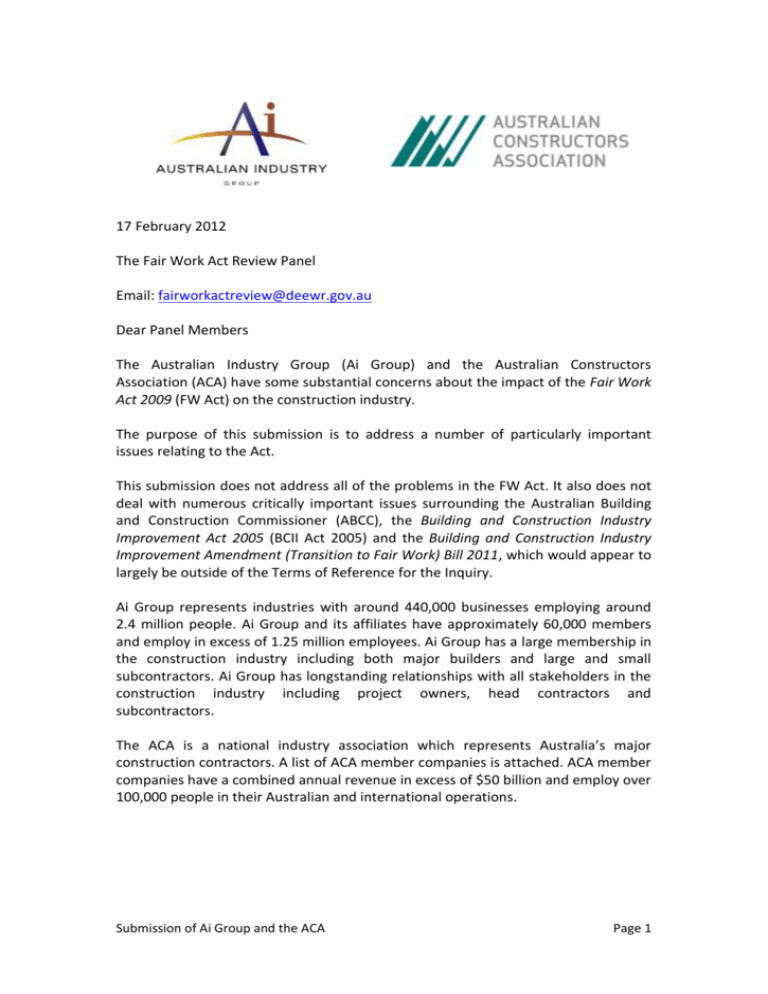
17 February 2012 The Fair Work Act Review Panel Email: fairworkactreview@deewr.gov.au Dear Panel Members The Australian Industry Group (Ai Group) and the Australian Constructors Association (ACA) have some substantial concerns about the impact of the Fair Work Act 2009 (FW Act) on the construction industry. The purpose of this submission is to address a number of particularly important issues relating to the Act. This submission does not address all of the problems in the FW Act. It also does not deal with numerous critically important issues surrounding the Australian Building and Construction Commissioner (ABCC), the Building and Construction Industry Improvement Act 2005 (BCII Act 2005) and the Building and Construction Industry Improvement Amendment (Transition to Fair Work) Bill 2011, which would appear to largely be outside of the Terms of Reference for the Inquiry. Ai Group represents industries with around 440,000 businesses employing around 2.4 million people. Ai Group and its affiliates have approximately 60,000 members and employ in excess of 1.25 million employees. Ai Group has a large membership in the construction industry including both major builders and large and small subcontractors. Ai Group has longstanding relationships with all stakeholders in the construction industry including project owners, head contractors and subcontractors. The ACA is a national industry association which represents Australia’s major construction contractors. A list of ACA member companies is attached. ACA member companies have a combined annual revenue in excess of $50 billion and employ over 100,000 people in their Australian and international operations. Submission of Ai Group and the ACA Page 1 Introduction The building and construction industry is a much better place to work and invest today than prior to the Royal Commission into the Building and Construction Industry (2001-03). The reforms have provided huge benefits to employers, employees and the community. Unfortunately the construction industry reforms are currently being eroded day by day and there is a very real risk of the damaging and unproductive industrial relations practices of the past returning to the industry and once again becoming entrenched. The FW Act has an important role to play in this regard. The Royal Commission made 212 recommendations in its final report, most of which were addressed in a Bill introduced into Parliament in 2003.1 However, that Bill was substantially amended and the package of legislative reforms was enacted through: The BCII Act 2005; and Amendments to the Workplace Relations Act 1996. Given the above approach to implementing the reforms, numerous important Royal Commission recommendations were dealt with in the Workplace Relations Act 1996 and are now dealt with in the FW Act. These recommendations address subject matters such as: Bargaining and agreement making; Industrial action; Right of entry; and Freedom of association. Content of agreements Currently agreements are able to include content which extends beyond ‘permitted matters’ so long as those matters are not ‘unlawful terms’. This expansive approach to agreement content has been very damaging for the construction industry because unions have pressured employers to include a wide range of highly restrictive and unproductive provisions in agreements including, for example: 1 Restrictions on the use of sub-contractors and on-hire arrangements; Requirements to notify unions of the names of proposed sub-contractors (which of course results in pressure upon employers to only engage those sub-contractors which the unions support); Wider rights for unions to enter construction sites than those in the FW Act; and Requirements for employers to promote union membership. Building and Construction Industry Improvement Bill 2003. Submission of Ai Group and the ACA Page 2 The Victorian electrical contracting industry pattern agreement, which was the subject of Ai Group’s appeal in the ADJ Contracting2 case, highlights some of the problems. The pattern agreement includes highly restrictive and inappropriate clauses dealing with the use of sub-contractors, union entry rights and the promotion of union membership by employers. In addition to the problems relating to pattern agreements, agreement content is a major problem for employers wishing to enter into greenfields agreements for new construction projects. Unions typically refuse to sign a greenfields agreement unless the employer agrees to the clauses which the unions are pressing and have secured in other agreements. Many of the clauses demanded are most likely not ‘permitted matters’ under the FW Act (e.g. highly restrictive clauses dealing with the use of subcontractors), and they would have been unlawful under the Workplace Relations Act 1996. It is essential that the definition of ‘permitted matters’ in the FW Act is amended to only include matters pertaining to the employment relationship as determined by the High Court of Australia in the Electrolux case.3 Any content which is not a matter pertaining to the employment relationship should not be able to be included in an enterprise agreement, nor should industrial action be protected if any matters are being pursued which are not matters pertaining to the employment relationship. Further, the list of ‘unlawful terms’ in the FW Act should be replaced with the following: 2 3 Matters which are not ‘permitted matters’; Clauses which impose restrictions or limitations on independent contractors, on-hire employment or outsourcing; Discriminatory provisions; Terms dealing with union right of entry (i.e. The provisions in the FW Act should not be able to be circumvented); Terms which deal with the provision of information about employees bound by the agreement, contractors or on-hire providers to trade unions; Terms about unfair dismissal (i.e. The provisions in the FW Act should not be able to be circumvented); Terms about industrial action (i.e. industrial action must not be permitted during the life of an enterprise agreement). The Australian Industry Group v ADJ Contracting Pty Ltd, [2011] FWAFB 6684. Electrolux Home Products Pty Ltd v The Australian Workers Union and Ors [2004] HCA 40. Submission of Ai Group and the ACA Page 3 Furthermore, the definition of ‘objectionable term’ in the FW Act should be amended in line with the definition of ‘objectionable provision’ in the Workplace Relations Act 1996 given that the Full Bench of FWA in the ADJ Contracting case decided that there were material differences between the two definitions and, as a consequence, the ‘union promotion’ clause in the ADJ enterprise agreement was not an objectionable term under the FW Act. The clause would have undoubtedly been an objectionable provision under the Workplace Relations Act 1996. Greenfields agreements Greenfields agreements are widely used and extremely important in the construction industry. As discussed above, the content of such agreements is currently a major problem. A further problem is the power imbalance between unions and employers in negotiating greenfields agreements. The reality is that a head contractor usually needs to have an enforceable agreement in place to manage industrial risk on a project. Unions currently have too much power to refuse to enter into a greenfields agreement unless all their demands are met. To address the power imbalance, the following provisions should be reintroduced, as were formerly in place under the Workplace Relations Act 1996: Greenfields agreements should be able to be entered into with any union eligible to represent any employees on the project; Employer greenfields agreements should be reintroduced. (NB. Employer greenfields agreements in the construction industry typically included generous terms and conditions, consistent with those paid on other projects of the relevant type. The availability of these agreements was important in influencing unions to adopt a reasonable approach in greenfields agreement negotiations). Industrial action / bogus safety disputes Industrial disputes in the building and construction industry can be extremely costly. A one-day stoppage on a major project can cost hundreds of thousands of dollars. In addition to the more obvious direct costs of the industrial action, there are numerous other costs which arise due to delays in completion resulting from industrial action. These costs include: Liquidated damages; Damage to the contractor’s reputation which may result in the loss of future business; Program acceleration expenses, e.g. extra overtime; Daily costs of hire for rental equipment, such as cranes, mobile plant, sheds, offices and other equipment; and Submission of Ai Group and the ACA Page 4 The effects of inflated sub-contractor tender prices, which tend to occur on trouble-prone projects. One area of great concern to contractors is the additional stresses that arise due to accelerated ‘catch-up’ programs, which need to be implemented when delays have been caused by industrial disputes. Such programs can have a negative effect on safety and quality, plus result in significant additional costs. In addition, industrial action taken by the employees of one company typically creates significant hardship for other companies and their employees, due the interrelated nature of the activities carried out by sub-contractors. The BCII Act 2005 includes additional protections against unlawful industrial action which are only applicable to the building and construction industry. These additional protections will be lost if the Building and Construction Industry Improvement Amendment (Transition to Fair Work) Bill 2011 is enacted. If this occurs, as appears likely, employers will need to rely solely on the provisions of the FW Act. For this reason it is vital that the protections in the FW Act are tightened up. Bogus safety disputes are still a problem in the construction industry. Over the years OHS has often been misused by unions as an industrial weapon against employers. It is essential that strong laws remain in place to prevent this highly inappropriate and damaging tactic. Bogus safety disputes have cost the industry dearly. The misuse of OHS by unions as an industrial weapon fosters an attitude of cynicism amongst employers towards safety concerns raised by union officials and delegates. This, in turn, negatively impacts upon OHS in the industry. The onus of proof should be on the employees and their representatives to establish that action taken over health and safety is based on a reasonable concern of the employees about an imminent risk to their health and safety. Like the definition of ‘industrial action’ in the Workplace Relations Act 1996, the definition of ‘industrial action’ in section 19 of the FW Act excludes industrial action based on a reasonable concern by an employee about an imminent risk to his or her health or safety. However, unlike the FW Act, the Workplace Relations Act 1996 placed the onus of proving that there was a reasonable concern about an imminent risk on the person alleging this. This was a direct response to findings of the Royal Commission that OHS was regularly being exploited in the industry to further industrial objectives. A similar onus of proof is included in the BCII Act 2005, but this provision will be lost if the Building and Construction Industry Improvement Amendment (Transition to Fair Work) Bill 2011 is enacted. The definition of ‘industrial action’ in section 19 of the FW Act needs to be amended to incorporate the approach in the Workplace Relations Act 1996 and the BCII Act 2005. This approach would outlaw the misuse of OHS, but the rights of employees to refuse to perform duties which are genuinely unsafe would be protected. Submission of Ai Group and the ACA Page 5 Right of entry Unions have an important representative role to play. Accordingly, an appropriate balance needs to be struck between protecting employers from the misuse by unions of right of entry and inspection powers (which the Royal Commission held to be highly prevalent in the construction industry) and retaining an entry and inspection regime which enables unions to represent their members effectively. The current provisions of the FW Act do not strike the right balance. It is essential that enterprise agreements not be permitted to circumvent the right of entry provisions of the FW Act. As is highlighted by the decision of the majority and the minority of the Full Bench in the ADJ Contracting case, the existing ‘unlawful term’ relating to right of entry is too vague and problematic. Under the Workplace Relations Act 1996, enterprise agreements were not permitted to include right of entry provisions. This provision should be reinstated. The FW Act includes a comprehensive scheme for union right of entry that is fair and balances the interests of all parties. Such a scheme should not be undermined through enterprise agreements, as is currently occurring in the construction industry. General protections The General Protections in the FW Act are causing widespread problems for employers in the construction industry. The provisions: Are extremely broad in nature which creates risk and uncertainty for employers; Impede employers in effectively managing their businesses, including limiting their ability to: introduce new work practices, take disciplinary action against a worker where necessary, etc; Severely restrict employers in dealing with inappropriate or unlawful industrial activities; Are being misused on a wide scale by employees to circumvent the unfair dismissal laws. In Ai Group’s submission to the FW Act Review these problems are discussed in detail and legislative amendments are proposed to address them. Submission of Ai Group and the ACA Page 6 Transfer of business The transfer of business provisions in the FW Act are imposing unreasonable restrictions on construction industry employers. Consistent with the High Court’s decision in the PP Consultants4 case, the ‘character of the business’ test should be reinstated through an amendment to subsection 311(1). Also, the High Court’s decision in the Gribbles5 case is extremely important for companies in the construction and contracting industries and the important principles which arose from this case need to be preserved. To achieve this, subsection 311(3) of the FW Act should relate only to the transfer of the ownership of assets, not the use of assets. Further, the transfer of business provisions operate as a major impediment to transferring employees from one operating entity in a corporate group to another, including when a project is finished. This is particularly damaging in the construction industry given the project-nature of the work. Section 311(6), which relates to ‘associated entities’, needs to be deleted. Conclusion The reforms which have been introduced in the construction industry over the past seven years have supported a generational change in the culture of the industry. However, the construction industry reforms are currently being eroded day by day and the damaging and unproductive industrial relations practices of the past are creeping back into the industry. The changes which we have proposed to the FW Act are essential to address these problems and risks. Yours faithfully Heather Ridout Chief Executive Australian Industry Group 4 5 Peter Brecht President Australian Constructors Association [2000] HCA 59. Gribbles Radiation v HSU [2005] HCA 9 Gribbles Radiation v HSU [2005] HCA 9 Submission of Ai Group and the ACA Page 7 Members of the Australian Constructors Association 1. Abigroup Limited 2. Baulderstone Pty Ltd 3. BGC Contracting Pty Ltd 4. Brookfield Multiplex Limited 5. CH2M Hill Australia Pty Ltd 6. Clough Limited 7. Downer EDI Limited 8. Fulton Hogan Pty Ltd 9. Georgiou Group Pty Ltd 10. John Holland Pty Ltd 11. Laing O’Rourke Australia Construction Pty Limited 12. Leighton Contractors Pty Limited 13. Leighton Holdings Limited 14. Lend Lease Pty Ltd 15. Lend Lease Infrastructure Pty Ltd 16. Macmahon Holdings Limited 17. McConnell Dowell Corporation Limited 18. Thiess Pty Limited 19. United Group Limited 20. Watpac Limited Submission of Ai Group and the ACA Page 8




